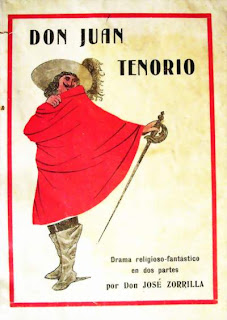
And so the journey begins to be chronicled. Thanks to a great conversation with Lisa Coye, our Muertos researcher and dramaturge, we landed on the story.
Don Juan, the spirit, has returned to celebrate Dia de muertos but as in past years, no one has built an altar for him. Why would anyone? Don Juan has a terrible reputation, he was a womanizer, a man who used his vast wealth to buy his way into the hearts and beds of countless women, betraying them and dishonoring their families. He was a scoundrel and cheat in other ways, all for the sake of his glory. Now dead, no one honors him or longs for reunion on Dia de muertos. This bothers Don Juan deeply, because he loved life and wishes for nothing more than to be able to enjoy the pleasures of life if only once a year on the Day of the Dead.
Don Juan knows that the source of his trouble is the play written by Jose Zorrilla in 1844,
Don Juan Tenorio. It has painted him as such a rogue that there's no room for redemption (even if the play offers one through the actions of Dona Ines at the very end of the play). Don Juan must find a way to undo the harmful effects of Zorrilla's play.
By this time, 1890 or so, the play is now a seasonal favorite, performed annually for Dia de muertos celebrations. A rag-tag acting troupe arrives at the town square to practice their version of Don Juan Tenorio for the upcoming procession.
Don Juan decides to intervene, to join the troupe and change the ending of the play. He manages to sidetrack the actor who would've played DJ and inserts himself into the company.
Meanwhile, we meet the actors of the troupe, including the young ingenue who'll play the role of Ines (Don Juan's fiancee whom he ruined, but who forgave him). Don Juan is struck by her resemblance to Ines, who died. The ingenue is accompanied by her closest friend and confidante, the woman who raised her since she was a baby. As our ingenue approaches marrying age, her confidante reveals to the ingenue that she is none other than the daughter of Don Juan! Apparently Ines gave birth just before she died from shame.
Furthermore, the ingenue is now an heiress to Don Juan's vast fortune.
Righteous girl that she is, she doesn't want any part of the money or his name, she despises everything he stood for, including his licentuousness and ego.
Don Juan, on the other hand, is deeply hurt. He had no idea he was a father, and it touches something in him, a sense of paternal responsibility for this lovely child even though she will have nothing to do with him.
While the girl's identity and fortune were being revealed to her, the conversation was overhead by another actor (who plays the role of Don Luis, Don Juan's enemy), who grows keenly interested in her beauty and potential inheritance. He decides to go after her, seduce her, marry her and share her wealth.
When Don Juan learns of this, he recognizes the actor is a true Don Juan, a thief and scoundrel, and vows to protect his daughter from him. Don Juan battles Don Juan and the father wins.
Our ingenue recognizes that her father is not the devil he's been purported to be, there is a happy reunion, and she promises to build him an altar from that point forward.
Viva Don Juan!
 On Aztec acting styles:
On Aztec acting styles:




